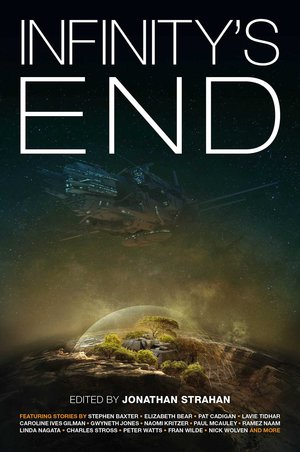How Science Fiction Was Saved by Solaris and Jonathan Strahan
 A few years ago Black Gate asked “Is the Original SF and Fantasy Paperback Anthology Series Dead?” Those were dark, dark days, and I don’t like to think of them.
A few years ago Black Gate asked “Is the Original SF and Fantasy Paperback Anthology Series Dead?” Those were dark, dark days, and I don’t like to think of them.
They’re over now. Science fiction was rescued from a barren wasteland of paperback sameness by the one publisher who had a decent shot: Solaris. They did it by taking a chance on a paperback anthology series that has become one of the most acclaimed and celebrated of the past few decades: Jonathan Strahan’s Infinity Project, which comes to a triumphant end this month with Infinity’s End, certain to be one of the most talked-about books of the year.
You see, years ago original anthology series like Damon Knight’s Orbit, Terry Carr’s Universe and Robert Silverberg’s New Dimensions were the very centre of science fiction, providing a prestigious and high-paying market for short fiction. They showcased the top names as well as up-and-coming talent. I could plunk down my three bucks at W.H. Smith in Halifax, Nova Scotia, knowing that the slender paperbacks I excitedly carried home would introduce me to half a dozen new writers.
Those books sold well, but publishers were savvy enough to know that it wasn’t just about the bottom line. When I read stories like Ursula K. Le Guin’s “The Ones Who Walk Away from Omelas” (from New Dimensions 3, 1974), Howard Waldrop’s “The Ugly Chickens” (Universe 10, 1981), or Isaac Asimov’s “The Bicentennial Man” (Stellar 2, 1977), I immediately began haunting book store stacks for books by Le Guin, Waldrop, and Asimov. There’s no reader as observant or loyal as a science fiction fan, and paperback anthologies, cheap and plentiful, were the perfect way to get authors in front of hungry new readers.
The economics of publishing gradually changed over the decades, of course, and those changes eventually wiped out the original paperback series. DAW’s long-running “paperback magazine,” the monthly anthology edited by Martin Greenberg and his associates at Tekno Books, was the last of them, and when Marty passed away in 2011, DAW killed it, too. Old timers like me shook their heads, muttering “No one reads short stories any more.” True or false, that grumpy sentiment became conventional wisdom in American publishing. No one would take a chance on something as provably dead as anthologies. That meant fewer readers finding new writers, and fewer sales for those writers. The field slowly withered without a prestige anthology series, and it looked like it would do so forever.
Until Solaris, and Strahan.
[Click the images for Infinite-sized versions.]
The Infinity Project began in an unassuming way, with the release of the mass market paperback edition of Engineering Infinity in 2010.
But as the years went by it relentlessly accumulated accolades, and sales. In 2014 Tor.com said “No one publisher has done as much for the short form of speculative fiction in Britain as Solaris,” and Black Gate proclaimed Meeting Infinity the “Most Successful Anthology of 2015,” with over 50% of its contents snapped up by Year’s Best volumes.
While Strahan delivered — and how — on the editorial side, Solaris has simultaneously been tireless in their promotion and support of the books. Virtually all of the titles remain in print; good news for those of you who are just catching on now. That includes Engineering Infinity, eight long years later.
The previous volumes in The Infinity Project
 Other publishers are taking note of Solaris’s success, and I’m seeing the first recent stirrings of American publishers beginning to experiment with prestige anthologies again.
Other publishers are taking note of Solaris’s success, and I’m seeing the first recent stirrings of American publishers beginning to experiment with prestige anthologies again.
That includes Neil Clarke’s 3-book-a-year deal with Night Shade, which has already produced anthologies like Galactic Empires and The Final Frontier, Dominik Parisien and Navah Wolfe’s annual volumes at Saga Press, which began with last year’s delightful Starlight Wood and continued this year with Robots Vs. Fairies, and Bryan Thomas Schmidt’s Infinite Stars at Titan, just as a few examples.
And what about Strahan? Although he’s wrapping up the Infinity Project with Infinity’s End, that doesn’t mean he or Solaris are done with anthologies. His website lists two new projects, his 50th and 51st books, coming in the next two years:
50. Mission: Critical, Jonathan Strahan ed., Solaris Books, July 2019, tp
51. untitled fantasy anthology, May 2020, hc
Strahan’s editor at Solaris over the years was Jonathan Oliver, who has now moved on. Oliver was a fine editor in his own right, with anthologies like Dangerous Games and House of Fear to his credit. I’m not sure if Olliver’s departure has anything to do with the end of the Infinity Project, and what it will mean to Strahan’s future anthology projects at Solaris. But the fact that he has two additional books in the queue is a positive sign.
Before I get too alarmed about the future, we still have one more book in the Infinity Project to enjoy. And from the look of Infinity’s End, it will be one of the best. Here’s the Table of Contents.
“Last Small Step,” Stephen Baxter
“Prophet of the Roads,” Naomi Kritzer
“Nothing Ever Happens on Oberon,” Paul McAuley
“Swear Not by the Moon,” Seanan McGuire
“Longing For Earth,” Linda Nagata
“A Portrait of Salai,” Hannu Rajaniemi
“Death’s Door,” Alastair Reynolds
“Foxy and Tiggs,” Justina Robson
“Intervention,” Kelly Robson
“Once on the Blue Moon,” Kristine Kathryn Rusch
“Talking to Ghosts at the Edge of the World,” Lavie Tidhar
“Kindred,” Peter Watts
“The Synchronist,” Fran Wilde
Here’s the text from the back cover.
The highly-anticipated final volume of the critically-acclaimed science fiction anthology series
Life in space is hard, lonely and the only person you can rely on is yourself. Whether you’re living deep in the gravity well of humanity’s watery home, mucking out air vents in a city floating high in the clouds of Jupiter, or re-checking the filtration system on some isolated space station, life is hard and demanding, and life is small.
The stories of Infinity’s End are set in those empty spaces, in futures where planets have been disassembled and reused for parts, or terraformed and settled; where civilisations have risen and fallen; where far future people make their lives anywhere from colonies hanging in the clouds of Neptune or Venus to the repurposed cores of distant asteroids; on worldlets and asteroids, inside Saturn’s rings or distant spheres and wheels, on-board ships trucking from home to home, and port to port. They’re set in a future that’s lived in. And they make it clear that even if we never leave the Solar System, there’s life enough and room enough to live out all of science fiction’s dreams.
Infinity’s End is the future. The stories you’ll find here are the stories of your life.
Plenty other folks here have reviewed The Infinity Project anthology series over the years. Check out their thoughts below.
Engineering Infinity (2010)
Edge of Infinity (2012)
Reach For Infinity (2014)
Meeting Infinity (2015)
Bridging Infinity (2016)
Infinity Wars (2017)
Infinity’s End will be published next week. Order copies here, and get more details at the Solaris website.
Todd McAulty published four novellas in the print version of Black Gate, including “There’s a Hole in October” and “The Haunting of Cold Harbour.” His first novel The Robots of Gotham was published in hardcover by Houghton Mifflin Harcourt in June. Learn more at HauntedStars.com.
